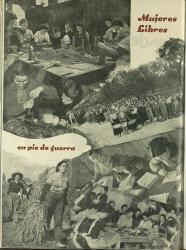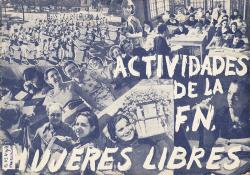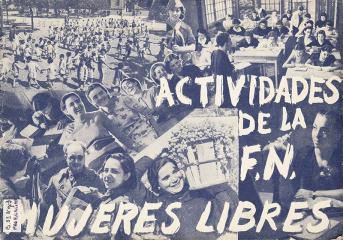The social revolution illustrated (1936-1938)
Andrés Antebi, Pablo González, Teresa Ferré and Pau Martínez (Observatori de la Vida Quotidiana)
10.05.2018
Andrés Antebi, Pablo González, Teresa Ferré and Pau Martínez - Observatori de la Vida Quotidiana (OVQ)
Thursday 10 May at 6.30 pm. Virreina LAB
Free entrance. Limited places
Seminar on the wealth of illustrations, photographs and films produced in anarchist society during the years of the Revolution, drawing from specific case studies such as the graphic magazine Umbral, the figures of Mateo Santos and Ángel Lescarboura and the reports of Pérez de Rozas about collectivisations.
www.graficaanarquista.com
Observatori de la Vida Quotidiana (OVQ) An independent and transdisciplinary collective coordinated by anthropologist Andrés Antebi and historian Pablo González which has been working on historical and ethnographic research projects in Barcelona since 1999. Its main objective is to combine social research tools with the evocative power of graphic and visual arts. In recent years its output (books, exhibitions, documentaries and websites) has explored issues as diverse as the history of photojournalism, public demonstrations and movements, Barcelona’s colonial footprints and building the historical memory of neighbourhoods using household photo collections.
Teresa Ferré Degree in Journalism and doctoral studies in Contemporary History from the Autonomous University of Barcelona (UAB). She is currently a lecturer in the History of Journalism at the UAB and Rovira i Virgili University (URV). Her academic research focuses largely on photography and propaganda during the interwar period, especially images of the Civil War and Republican exile, and Agustí Centelles, whose diary written in Bram concentration camp she has edited, among other work. A culture journalist, she writes about theatre at www.recomana.cat and on the Notes d’Escena blog. Since 1997 she has worked in cultural management and communication at festivals including FiraTàrrega and La Mostra d’Igualada and for organisations such as the Ramon Llull Institute. She is collaborating with the Observatori de la Vida Quotidiana on the project La imatge velada (The Veiled Image), which seeks to recover the legacy of Catalan photojournalism from 1900 to 1939, and the research and exhibition about the Pérez de Rozas journalism dynasty. As part of Gràfica Obrera Anarquista (Workers’ and Anarchist Graphics) she has curated the exhibition “1937. Quan la ribera no tenia amo. Crònica de la Col·lectivitat General d’Amposta” (1937. When the Riverbank had no Owner. The Story of the Amposta General Collective) at the Museum of les Terres de l’Ebre.
Pau Martínez Muñoz He has a Degree in Art History and a PhD in Communication from Pompeu Fabra University (UPF) in Barcelona. In 2006 he won the Cinema Rescat Film Research Award for his book Aportacions inèdites a la filmografia sobre la Guerra Civil espanyola. Dos documentals anarquistes produïts a Barcelona: Aragón trabaja y lucha i Ruinas y sangre de España. (Unpublished Contributions to the Filmography of the Spanish Civil War. Two Anarchist Documentaries Produced in Barcelona: Aragón Works and Fights and Ruins and Blood of Spain) He has published articles and books about anarchist filmography, the most prominent being La cinematografia anarquista en Barcelona durante la Guerra Civil (1936-1939) (Anarchist Films in Barcelona during the Civil War (1936-1939)) and Mateo Santos. Cine y anarquismo. República, guerra y exilio mexicano (Mateo Santos. Film and Anarchism. Republic, War and Mexican Exile). He is a member of the Spanish Association of Film Historians and has presented papers at several of its conferences.










